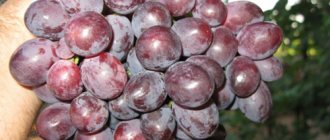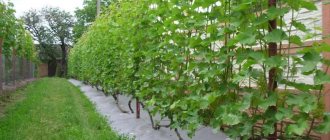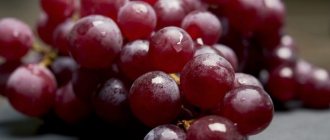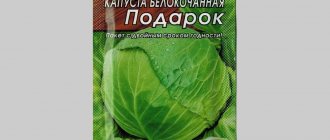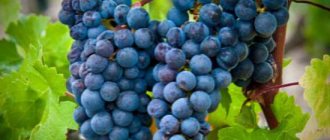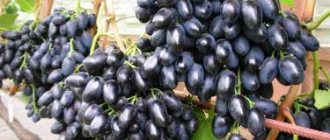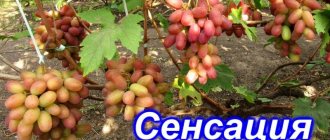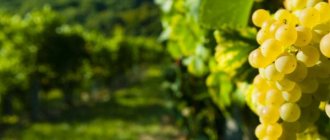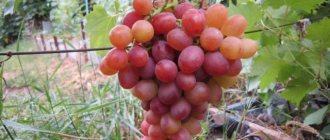Advantages and disadvantages
Like any other variety, “Helios” has its advantages and disadvantages.
Pros:
- Early ripening.
- Unusual taste.
- High yield.
- High resistance to major grape diseases.
- Suitability for transportation and long-term storage.
- Resistance to cracking, peas and wasp attacks.
Minuses:
- The need for fertilizing and regular watering.
History of growing Helios grapes
The well-known Russian amateur-originator of grape varieties V.N. Krainov, inspired by the successes of the breeding work of I.A. Kostrikin and carried away by its directions, in 1995 conducted his first experiments in crossing vines of different species in order to obtain hybrids with seedless or pink-colored berries. The new hybrid had to be so highly marketable as to meet the most demanding criteria of the grape market.
It was thanks to the painstaking work of the breeder, who selected only about 50 promising hybrids from hundreds of seedlings, that Helios table grapes were created. The parent pair was the table hybrid Arcadia and sultana Nakhodka, hence the second name of the variety - Arcadia pink.
Helios, like other hybrids of V.N. Krainov, has already managed to win the love of many winegrowers and has established itself in the southern and central regions of the former Union, displacing the traditional varieties of its predecessors.
Main characteristics
“Helios” is an early, vigorous variety with large pink berries and unsurpassed taste. It is also worth noting such early varieties as “Gourmet Early” and “Victor”.
Ripening period
From the beginning of the growing season to the technical ripeness of the fruit, 110–115 days usually pass. The variety is early ripening, since the harvest begins in early August.
Bush structure and wintering
The hybrid bush is vigorous, the leaves are large, the flowers are bisexual. The variety can be used as landscaping on the facades of houses, gazebos, hedges, and arches. The plant can tolerate temperatures as low as -24ºС, but winter insulation is required.
Reference! The “Helios” variety is recommended for cultivation in regions with a warm and mild climate; cultivation is also permissible in the regions of the middle zone, but subject to mandatory shelter.
Bunches and berries
The cone-shaped clusters are very massive: the average weight of one bunch is 600–900 g, and clusters weighing up to 1.5 kg are often found. The berries do not fit tightly together in the brush, but the brush looks like a single whole.
The berries of the “Helios” variety are quite large (about 13–15 g each) and have an oval shape. The red-pink skin is dense, not prone to cracking, but easily eaten. The pulp is fleshy, dense, juicy. There are 1 – 2 seeds inside the berries. The sugar content in fruits is up to 16%, acid content is 6 g/l.
Taste
Helios has an interesting, unique nutmeg taste with light fruity and floral notes.
Yield and storage
If all the requirements for cultivating the crop are met, from one Helios grape bush you can get from 7 to 20 kg of ripe berries. In industrial volumes the figures are different: up to 13 tons per hectare.
The dense peel reliably protects the berries from mechanical damage, so “Helios” is recommended for long-distance transportation and long-term storage.
Landing
This process is a very important stage in the life of a plant. If the planting technique is not performed correctly, the plant may suffer in the future. This will manifest itself in a decrease in the quantity of harvests and a decrease in its quality. Planting is carried out in spring or autumn. Autumn plantings should be protected from frost with shelter.
Selection of seedlings
It is necessary to ensure that the young plant has a healthy and developed root system. The sprouts should be green, without kinks, signs of rot or other diseases. The length should reach 20-22 cm.
Before planting, cut off the side shoots and dip the roots in a solution for 24 hours to stimulate root formation.
Preparing the site
This variety exhibits unusual capriciousness when choosing soil. It is able to grow and develop productively only on fertile soils.
Planting holes should be placed at a distance of 3 m from each other. The depth should be at least 80 cm. A 5-10 cm layer of drainage should be laid at the bottom of the bed, and fertilizer should be placed on top of it. "Helios" takes well to a mixture of superphosphate, potassium salt and organic fertilizers. Watering per plant is 8-10 liters.
A garter peg should be placed in the hole along with the seedling. It will become a support for the above-ground part and protect the root system from subsidence. You need to form a hole around the stem. Some gardeners advise covering the ground with a layer of sawdust to prevent the soil from drying out.
Comparison with analogues
“Helios” is one of the best varieties of early pink grapes: it has high yields, a relatively large cluster, an interesting taste and can be stored for a long time without loss of taste.
| Sign | Variety | |||
| Helios | Kostrikin's anniversary | Transfiguration | Timur pink | |
| Ripening period | 100 – 115 days | 100 – 115 days | 110 – 115 days | 110 – 130 days |
| Frost resistance | -24С | -24С | -23C | -25C |
| Productivity | 7 – 20 kg | Up to 15 kg | Up to 20 kg | 12 – 16 kg |
| Bunches | 600 g – 1.5 kg | 400 – 500 g | 700 g – 3 kg | 400 g – 800 g |
| Taste | Fruity and floral notes | Taste of honey | Sweet with slight sourness | Muscat notes |
| Color | Light red | Dark pink | Pink | Amber pink |
| Disease resistance | Above average | Above average | Average | Average |
| Shelf life | Up to 3 months | 1 – 2 months | 2 months | 2 months |
| Sugar accumulation | 16% | 18 – 20% | 17 – 19% | 22 – 25% |
| Acidity | 6 g/l | 6 – 7 g/l | 6 – 7 g/l | 6 – 7 g/l |
Advantages and disadvantages of the variety
Helios grapes have varietal advantages and disadvantages, namely:
- Pros:
- high taste qualities of the fruits, allowing them to be used in various areas of cooking and winemaking;
- consistently high productivity;
- lack of tendency to crush berries and crack the peel;
- resistance to diseases characteristic of grape crops.
- Minuses:
- whimsical care;
- average frost resistance - the variety needs winter shelter.
Useful properties and applications
Pink grapes “Helios” contain a number of useful substances, whose beneficial effects on the body do not need to be proven.
| Substance | Effect on the body |
| Vitamin A | Has a positive effect on the visual organs |
| B vitamins | Strengthens the nervous system and has antidepressant properties |
| Iron | Increases hemoglobin levels in the blood, fights anemia |
| Resveratrol | Strengthens the immune system, fights malignant tumors |
| Antioxidants phytoncides | Have antioxidant and anti-inflammatory properties |
| Ascorbic acid | Develops resistance to many infectious diseases |
| Cellulose | Normalizes the functioning of the digestive tract |
Reference! Eating Helios grapes in reasonable quantities will not harm your figure, since 100 g of berries contain 69 kcal.
The table variety “Helios” is recommended to be eaten fresh. You can also make wine, juice, compote, jam and preserves from it.
Features of cultivation
Regular watering and fertilizing of Helios grapes is the key to an excellent harvest.
Planting, watering and fertilizing
The “Helios” variety can be planted in the ground both in autumn and spring. Spring planting should be done only in warm weather (+12ºС – +15ºС) in relatively warm soil (+10ºС) in the absence of the threat of return frosts. In autumn, the crop should be planted 2 weeks before the first frost.
The heat-loving plant prefers a well-lit place with reliable protection from the wind in the form of a wall of any structure, fence or gazebo. The soil must be fertile, air and water permeable. The bush does not like captivity: the distance between neighboring plants should not be less than 2.5 - 3 meters. The optimal dimensions of the planting pit are 80x80x80 cm.
After planting, the young plant needs regular watering (as the soil dries), loosening and mulching. Typically, experienced winegrowers pour about 25 liters of water per square meter. An adult plant does not need such abundant watering; it is enough to moisten it well in early spring at a temperature with a “+” sign, then after spring pruning, before and after flowering, at the stage of berry formation and in the fall, after harvesting. If the summer turns out to be dry and hot, then increasing the amount of watering is quite acceptable. The recommended rate is 30 liters per sq.m. During autumn watering, at least 50 liters of water should be poured under each bush.
“Helios” requires regular feeding. The scheme for their application is standard: in the spring - ammonium nitrate, before and after flowering - potassium salt and superphosphate, in between - watering with the addition of organic fertilizers (bird droppings, slurry, wood ash).
Diseases and pests
Helios grapes are distinguished by strong immunity to oidium, mildew, and rot. It is not afraid of phylloxera and wasps. But for preventive purposes, twice a season (before and after flowering), the plant should be treated with a fungicidal agent, for example, Bordeaux mixture, and an insecticide.
Wasps cannot eat juicy berries because of the thick peel, but they like overripe berries.
Important! Special mesh bags with a fine cross-section can save the crop from wasps. These same bags will protect the grapes from birds.
Diseases and pests
Wasps do not take these grapes, but people have yet to develop a form that is not afraid of birds. Therefore, measures should be taken - install a mesh fence around the vineyard that would not allow birds to get to the berries. It must be tough and durable; rope nets are not suitable for this task - you need to protect the grapes, and not collect entangled and dead birds. It would be better if they pecked caterpillars and other pests.
Another, no less serious enemy is grape itch or felt mite . This one eats literally everything it sees - grape shoots, leaves, inflorescences, ovaries.
You can also carry it on anything - this includes planting material, garden tools, and even the wind. They fight it by spraying with sulfur-containing preparations, as well as acaricides. These are BI-58, Vertimek, Karate-Zeon, Aktara.
Bacterial cancer . Rarely, but still this disease can affect Helios. No remedies have yet been invented against it - or rather, they have been invented, but are in the experimental stage. May be affected by anthracnose and chlorosis.
Therefore, you will have to take care of the grapes, “treat” them with mineral fertilizers, water them and not injure the bushes. For sick units, there is only one way - uprooting and fire.
It’s a pity, but it’s better to sacrifice a bush than the entire vineyard, since this scourge spreads very quickly and nothing else can stop it.
As you can see, Helios does not require complicated care at all, and its benefits are incomparably greater - it is not afraid of frost, fungal diseases, or even wasps. These grapes are good for both experienced and novice gardeners who want to have something “special” on their plot, but are afraid that they will not be able to cope due to lack of experience.
Anyuta, Valery Voevoda, Romeo are also suitable for beginning winegrowers.
Photo
Next, check out the photos and reviews about the “Helios” variety.
Reviews
The berry is bright red, nipple-shaped, excellent in appearance and taste. There is a resemblance to Victor2 = Sympathy. Leonid, Nikopol, Dnepropetrovsk region.
Its taste is simply amazing! It also showed good resistance to disease. Elena Petrovna, Rostov region, Kamensk-Shakhtinsky
Excellent commercial grade. The taste is pleasant, but the pulp is a bit runny, so to speak. Valery, Tiraspol
